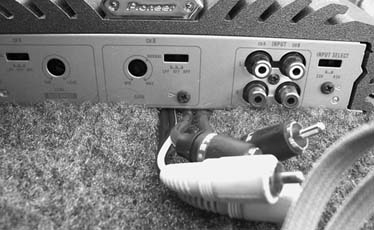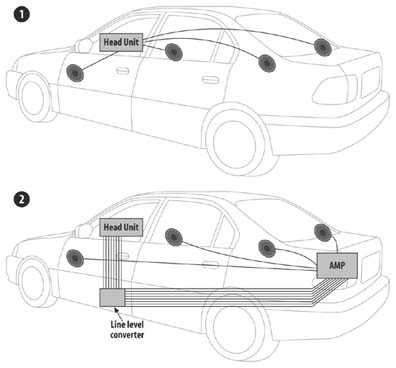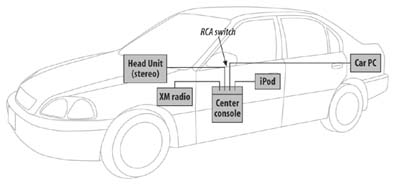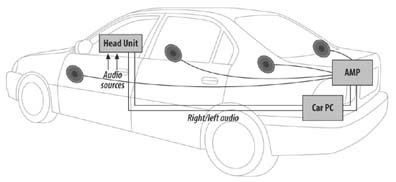Hack15.Amp Up Your Computer Audio
Hack 15. Amp Up Your Computer Audio
Connect your PC or other audio device directly to an amplifier, bypassing the head unit altogether. If you have an external amplifier in your vehicle, you may not have to adapt your head unit to get audio from external devices to play through your vehicle's speakers. Although the head unit/auxiliary-in approach in "Get Computer Audio into Your Head Unit" [Hack #14] gives you the ability to control the volume of all devices from the head unit, you can connect computers and portable devices with their own volume controls directly to the RCA inputs of your amplifier, bypassing the head unit altogether. 2.5.1. Amplifier InputsAmplifiers come in two-channel (stereo) and four-channel varieties, with a corresponding number of RCA inputs. You can see an amp and these inputs in Figure 2-8. Some amplifiers also have a set of "high inputs" that can take the output of a cheap head unit's built-in amplifier, convert it down to a lower level, and then reamplify it with the strength and audio fidelity of the amplifier. There are also separate line-level converters that can achieve the same function, for when your head unit doesn't have RCA outputs. If you install a separate amplifier for all your speakers, as in Figure 2-9, you can improve the sound quality and add additional options for inputting audio from sources other than the head unit. Figure 2-8. An amp and its RCA inputs Figure 2-9. Adding an amp to the sound path
2.5.2. Bypassing Your Head UnitThe nice thing about a computer is that it has line-level (0.54V) mini-jack outputs, which can be readily adapted to RCA inputs with a simple cable. This means that the computer can act like a head unit of sorts. There are several approaches to using this audio signal. 2.5.2.1 RCA switch box.In an approach similar to the one suggested in the section "Multiplexing Your Inputs" in "Get Computer Audio into Your Head Unit" [Hack #14], you can use an RCA switch box (audio only or audio/video) to connect multiple input devices directly into the RCA inputs on your head unit, as shown in Figure 2-10. The benefit of this approach is that you put the switch box in your center console, and it allows you to rapidly change between your head unit, your PC, and perhaps a portable audio device that you plug into the center console compartment. Figure 2-10. A hooked-up switch box The drawback of this approach is that you have only fairly clumsy control over the volume of your devices. Since the amplifier does not have its own volume control, it depends on the volume coming into it. While the head unit will work fine, PCs and portable devices usually have an amplified, non-line-level output, and if you forget to set the volume very low on the device itself, or accidentally raise it too high, you could blow out your speakers (or your ears).
2.5.2.2 PC pass-through.Another interesting and potentially very useful approach is to pass the head unit audio through the PC and connect the PC to the amplifier, as in Figure 2-11. In this way, you're using the computer as your mixer and head unit. If you can get a sound card that gives you preamplified line-level outputs, this is the safest approach, as it will not increase the volume to unsafe levels. Figure 2-11. Passing head unit audio through the PC to the amp Some PC sound cards even have a pass-through feature, where the input line is connected to the output line when the computer is offin this case, the head unit (radio, CD player) audio is passed directly to the amplifier. Other computers require the computer to be on, but allow you to set the pass-through audio in software. The interesting aspect of this approach to software developers reading this book is that you can implement some TiVo-like featuressuch as the ability to pause live radiofrom the head unit. As it passes through the computer, anything you play on the head unit can be recorded, ripped to MP3, processed with Winamp audio processor plug-ins, and so on. (In fact, that's one of the things we're currently working on at my company.) 2.5.2.3 Eliminating the head unit.Replacing your head unit altogether is the most adventurous approach. As your car computer takes on more responsibility for feeding you audio, you can simply reclaim the space in your dash and install a screen for your car computer there instead. Figure 2-12 shows how you'd hook it up to the amp. Figure 2-12. Using your PC as a head unit connected to the amp Obviously, this approach requires that you run software that controls all of your audio needs while you are driving, including selecting devices, adjusting volume, and so on. In essence, you are using a general-purpose computer to implement a head unit in software. Fortunately, there are a handful of applications out there (and more appearing every day) that control many aspects of car audio via a touchscreen. In Chapter 7, you'll find many hacks explaining these frontends in depth. |

